Clever 4Ever
The game

You try to achieve as many points as possible by cleverly using the dice in the five color areas. The dice should be chosen cleverly so that you still have enough options for subsequent throws. Bonus moves and actions offer you various opportunities to improve your result through clever use.
Gameplay
The game lasts 6 rounds with two players, 5 rounds with three players and 4 rounds with four players. Each round is divided into a main and a passive phase.

Main phase
In each main phase you roll the dice three times and use one of the dice that are still active. A further roll is then carried out with all 6 dice, of which you can then use one of the 3 dice with the smallest number.

You roll the dice at the beginning of a round with all 6 dice and choose one dice to use. Depending on the color of the die rolled, you now have to select a valid field in the appropriate color from the fields still available in this color. The white die is a color joker and can be used for any color.
All dice that show a lower value than the currently selected die are placed on the silver platter and cannot be rolled or used again this round.
Now roll the remaining dice a second time. You select a die again, and any dice that show a lower value than the one currently taken are placed back on the silver platter. You then roll the remaining dice a third time and carry out the actions described above one last time. Then all remaining dice are placed on the silver platter.
Passive phase

If you have used 3 dice or can no longer roll dice because all the remaining dice are on the silver platter, the second phase of a round follows.
All dice are rolled again and the 3 dice with the lowest value are placed on the silver platter. If there is a tie, the decision is made at random.
You can choose one die from these 3 dice and enter it. You can then use the +1 actions here too.
Special case: If you don't have the opportunity to use a die from the silver platter, you can use any die.
If you can't use any dice from the roll, you're unfortunately out of luck.
The 5 colors

Different rules for entering and scoring apply to each of the 5 colors . You always only use the die of the corresponding color (or the white joker) to enter something in the area.
Yellow< /span>
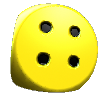
If you choose the yellow die, you are free to choose which of the 3 lines you want to enter the die value in.
You start at the far left in each line and enter the value in the next free field. So you are not allowed to skip a field.
You can choose which line you want to write in for each yellow die.
You can start with any number on the top line. However, in the following fields of this line you must always enter a number that is higher than in the previous field.
In the two bottom lines you can enter any numbers in each field .
Blue

Choose the blue cube , you have to tick exactly 1 field in this area.
As usual, whenever you choose the blue cube, you also use the white cube (no matter where it is).< /span>
The two dice determine the field to be ticked. The blue die determines the row and the white die determines the column. You tick the box on the intersection.
Gray

The gray area is divided into different areas. Each group of connected fields in the same color (white, light gray, dark gray) is such a sub-area.
If you choose the gray cube, you have to tick all the fields in a sub-area.< /span>
The number on the die must be at least as high as the number of fields in the area.
You start there with one of the two areas outlined in red on the far left. You must place all further crosses horizontally or vertically adjacent to an existing cross.
Green
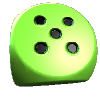
In the green area you can enter up to 2 numbers in each field. The fields are divided into 2 triangles by a green line.
If you have chosen the green die, you first have to decide whether you want to put the dice value in the top or in the enter the lower triangle. When entering, you fill in each of the two “lines” from left to right.
Pink
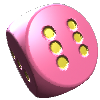
In the pink area you have numbers into the fields. You always start at the far left and enter a number in the next free field on the bar. So you are not allowed to skip any fields here.
Depending on the number you enter, the following happens:
The actions

After each roll of the main phase, you can re-roll the dice you just rolled using the “re-roll action”.

When you use a die from the silver platter, you may increase or decrease the number of that die by 1. You may also use this action multiple times to change the number by more than 1. 1 and 6 are not considered adjacent.

You also have the option before ending the main phase, as well as before ending the passive phase of each round to use the "extra dice action". This allows you to use another dice of your choice; it can come from the silver platter or from the area you have already used. However, each die can only be chosen once per turn as an additional die.
Bonuses and points
Some fields (or rows and columns) have a bonus. You get this when you mark the field (or when all fields in a row/column are marked). You also receive a bonus if you have collected all 6 of the 3 different actions (additional dice, number joker and additional dice actions). The bonus allows an entry in the corresponding color, or it grants a "post-roll, number joker or additional die action". The color bonuses must always be used immediately. If you get a fox, it brings additional points in the final score.
?-Bonus

You get one ?-Bonus you must immediately tick a box in the color area corresponding to the bonus.
Any ?-Bonus

For the bonus at the beginning of round 4, you can freely choose which color you want uses a bonus according to the rules above.
Fox

For foxes you get extra points at the end of the game. Foxes can be earned like bonuses by filling the corresponding field or completing a corresponding column.
Each fox scores as many points as the color area with the fewest total points.
Point scoring
The point scoring for the individual color areas is as follows represents:
Yellow
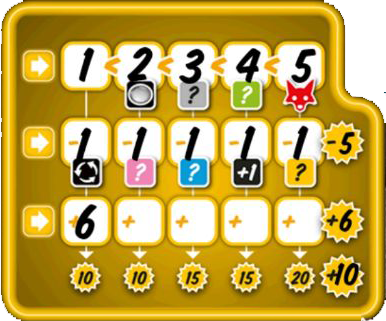
All entered numbers, in the middle line are added together and displayed in the field to the right of the line. You get this sum as minus points.
In the bottom line, all the numbers entered are also added up and entered in the field next to the line. You get these points as plus points.
You don't get any points in the top line.
Finally, you get points for each completely filled column. The points specified under the column are added together and the sum is entered in the field next to the line.
Blue
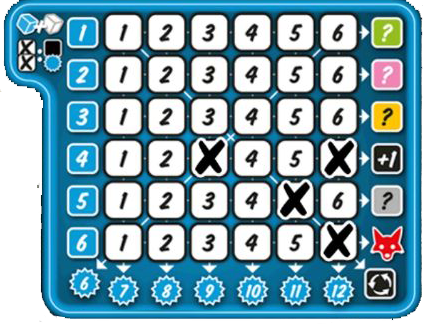
At the end of the game, for each column in which at least 2 fields are checked, you get the points indicated below this column.
You also get points if at least 2 fields in the diagonal from top right to bottom left are checked.
< span>Gray

At the end of the game, for each column that is completely ticked, you get the points that are indicated above this column.
Green

At the end of the game, all the points entered in the point fields are added up .
The point value consists of the sum of the two triangles in a field. This value is only obtained if numbers are entered in both triangles.
Pink
{20 }At the end of the game, the last field entered is relevant. You get the points indicated above this field.
You also get points for entered 2s, 4s and 6s (see also overview bar below the number fields).
End of game
The game ends after you roll the die in your passive turn in the last round from the silver platter and, if necessary, used any remaining +1 actions.
The points scored for all color areas are added together with the points for the foxes.

And let's go! From now on it's time to roll CLEVER 4 EVER.

